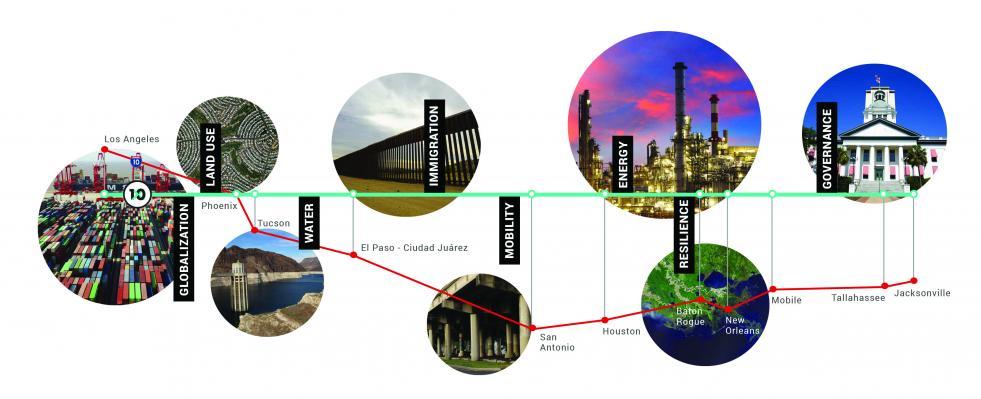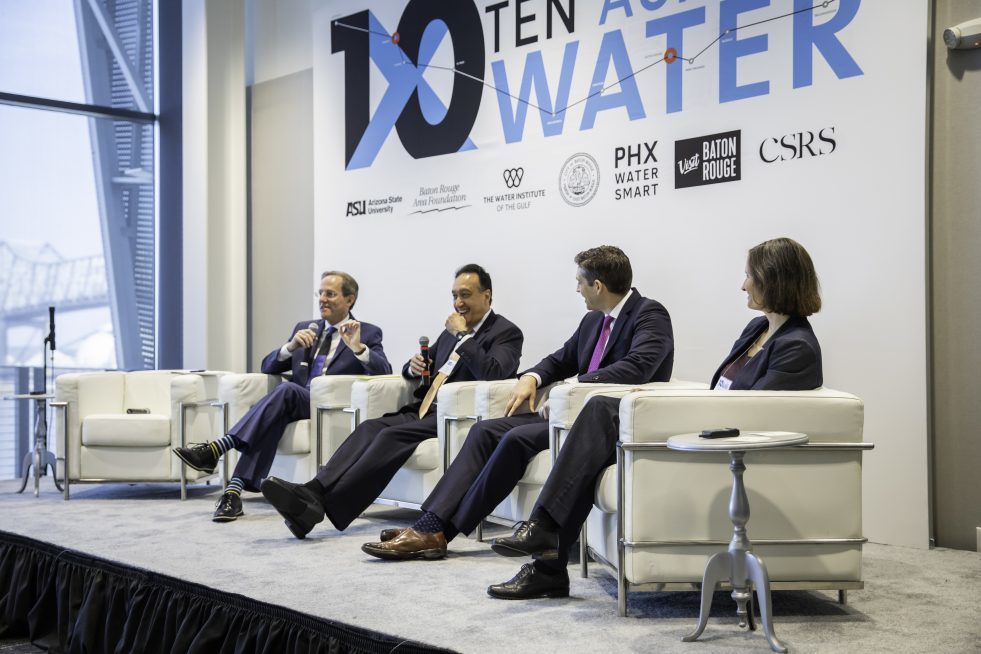Economic & Environmental Challenges Across the Interstate 10 Region

Who will you meet?
Cities are innovating, companies are pivoting, and start-ups are growing. Like you, every urban practitioner has a remarkable story of insight and challenge from the past year.
Meet these peers and discuss the future of cities in the new Meeting of the Minds Executive Cohort Program. Replace boring virtual summits with facilitated, online, small-group discussions where you can make real connections with extraordinary, like-minded people.
I have spent more than twenty years living and working in two cities whose very existence is challenged: New Orleans and Phoenix. In each case, water is the significant source of skepticism as to whether inhabitation can persist in its present form under such circumstances. Given their geographic dispositions—one below sea level, the other isolated in a harsh desert environment—there is a palpable lack of sympathy for those confronting flooding or drought in these seemingly illogical locations.
New Orleans, Phoenix, and some of the largest cities in the country are connected by the U.S. Interstate 10, the premier east/west axis that unites the two coasts and traverses the most rapidly expanding area of the nation in the process. Having “lived” the 10, I have come to see it as much more than a 2400-mile ribbon of concrete. This singular transect presents a uniquely American landscape, one shaped by industry, demographic change, global economic forces, and human interventions in a wide variety of delicate ecosystems.
In fact, I believe this corridor provides the most compelling window on the future of the country as a whole, one that presents the pressing issues of our time in their highest relief. In addition to the existential subject of water, this corridor is simultaneously on the front lines of human migration, wealth disparity, global commerce, climate change, and the grinding federal, state, and city gears of governance. It is a living laboratory like no other.

Ten Across (10X)
The challenges outlined above have no regard for artificial boundaries and will certainly not be constrained by them. Using the I-10 as a framing device, ASU, in partnership with a range of cities, universities, foundations and subject matter experts, has launched the Ten Across (10X) initiative, a project of a scale commensurate with the topics under review. 10X is conceived as a long-term effort, one enriched by repeated literal and figurative passes across the I-10, by unique explorations of each major subject, and by bearing three questions always in mind:
- What do we know? Ten Across will draw heavily on the nuanced observations of those living, working and adapting to rapidly changing circumstances in their respective communities. We especially want to capture voices that are not always the loudest but are revelatory, nonetheless.
- How can we know more? Supplementing the lived experience of those on the ground, new earth observing technologies now provide previously unimaginable insights into natural and man-made systems. They have also removed any excuses for not acknowledging the impact of human behaviors and decisions.
- What future will we choose? Having gathered information from the experiential to the abstract, the question is whether we will be able to decode and act on the evidence. Can we address the decisions before us with the urgency they deserve? And are our leadership and governance structures up to the task?
10X Asset Index
- The three most populous states in the U.S. (California, Texas, Florida)
- Five of the twelve largest cities (Los Angeles, Houston, Phoenix, San Antonio, Jacksonville)
- One of two U.S. “megacities” (Los Angeles)
- The carbon-based energy capital of the world (Houston)
- The largest bi-national metro in the western hemisphere (El Paso/Ciudad Juarez)
- International supply chain hubs (Los Angeles, New Orleans, Baton Rouge, Houston, Jacksonville)
- Three state capitals (Phoenix, Baton Rouge, Tallahassee)
- States w/ the largest immigrant populations (California, Texas, Florida)
- Five states w/ the high rates of poverty (Mississippi, Louisiana, New Mexico, Alabama, Texas)
Opposites attract
The recently concluded first annual Ten Across Water Summit demonstrated the utility of the 10X geography and the purposeful mixing and matching of different conditions. At this event, the subject of water was purposely bracketed by the “new normal” drought conditions of the desert southwest and the inundation and massive land loss of coastal areas along the Gulf of Mexico.
While these two ecosystems could not seem more unrelated, it was their difference that was key to a productive dialogue and meaningful exchange of ideas—the essence of the 10X platform. What was revealed were the common truths of resiliency. Conversations amongst the participants focused on forward-leaning strategies applicable to the spectrum of circumstances along the entirety of the I-10, and beyond. Emergent voices were heard, technologies demonstrated new ways of knowing, and the vital role of leadership was reinforced.

Guest speakers debate water, environmental and economic issues facing cities along the U.S. I-10 corridor during a 10X Water Summit panel discussion held Thursday, May 16, 2018 at the Water Campus in Baton Rouge, La.
As we begin to approach other critical issues and landscapes within the corridor, we intend Ten Across to serve as a forum for understanding the physical, social, economic, and cultural constructs which define us, and the “course corrections” required to achieve a more sustainable and inclusive society. The future has come early to this cross-section of the country and we intend to leverage it fully.
Fragile Futures
Ten Across is designed to accomplish two things: first, to represent the world as it is in all of its complexity and nuance and, second, to imagine alternatives to the present trajectory. To achieve the latter, as first illustrated through the Water Summit, the pairing of contrasting conditions can unlock new modes of understanding—which brings us back to two of our principal I-10 cities.
New Orleans—celebrating its 300th year—is positioned where a city should not be, but where one was necessary to control access to the Mississippi River and the interior of the North American continent. By contrast, Phoenix is a relatively new, artificial island built on twentieth century technologies and dependent on a slender lifeline of water, pumped hundreds of miles across the desert.
However different their origin stories and the ground upon which they are built, both cities are instructive reminders that even our grandest enterprises are only provisional. As such, they are emblematic of the Ten Across project – the necessity for keen observation and the active construction of new narratives for the future.
Decades ago, my graduate work concerned the vulnerability of New Orleans and why addressing a knowable threat (hurricanes, in this case) is so difficult. One cannot observe the Hoover Dam and the bathtub rings of Lake Mead without feeling similar anxiety about an insufficient sense of urgency in the West. As the esteemed author Jeff Goodell offers in his recent book, The Water Will Come, “…we are not wired to make decisions about barely perceptible threats that gradually accelerate over time. We’re not so different from the proverbial frog that boils to death in a pot of slowly warming water.”
If nothing else, the objective of Ten Across is to imagine a rewrite of history before it happens.
Discussion
Leave your comment below, or reply to others.
Please note that this comment section is for thoughtful, on-topic discussions. Admin approval is required for all comments. Your comment may be edited if it contains grammatical errors. Low effort, self-promotional, or impolite comments will be deleted.
1 Comment
Submit a Comment
Read more from MeetingoftheMinds.org
Spotlighting innovations in urban sustainability and connected technology
Middle-Mile Networks: The Middleman of Internet Connectivity
The development of public, open-access middle mile infrastructure can expand internet networks closer to unserved and underserved communities while offering equal opportunity for ISPs to link cost effectively to last mile infrastructure. This strategy would connect more Americans to high-speed internet while also driving down prices by increasing competition among local ISPs.
In addition to potentially helping narrow the digital divide, middle mile infrastructure would also provide backup options for networks if one connection pathway fails, and it would help support regional economic development by connecting businesses.
Wildfire Risk Reduction: Connecting the Dots
One of the most visceral manifestations of the combined problems of urbanization and climate change are the enormous wildfires that engulf areas of the American West. Fire behavior itself is now changing. Over 120 years of well-intentioned fire suppression have created huge reserves of fuel which, when combined with warmer temperatures and drought-dried landscapes, create unstoppable fires that spread with extreme speed, jump fire-breaks, level entire towns, take lives and destroy hundreds of thousands of acres, even in landscapes that are conditioned to employ fire as part of their reproductive cycle.
ARISE-US recently held a very successful symposium, “Wildfire Risk Reduction – Connecting the Dots” for wildfire stakeholders – insurers, US Forest Service, engineers, fire awareness NGOs and others – to discuss the issues and their possible solutions. This article sets out some of the major points to emerge.
Innovating Our Way Out of Crisis
Whether deep freezes in Texas, wildfires in California, hurricanes along the Gulf Coast, or any other calamity, our innovations today will build the reliable, resilient, equitable, and prosperous grid tomorrow. Innovation, in short, combines the dream of what’s possible with the pragmatism of what’s practical. That’s the big-idea, hard-reality approach that helped transform Texas into the world’s energy powerhouse — from oil and gas to zero-emissions wind, sun, and, soon, geothermal.
It’s time to make the production and consumption of energy faster, smarter, cleaner, more resilient, and more efficient. Business leaders, political leaders, the energy sector, and savvy citizens have the power to put investment and practices in place that support a robust energy innovation ecosystem. So, saddle up.






We have three US patents that describe a transportation system that can link New Orleans to Phoenix via abundant water. The Mississippi River has an excess 511 million acre feet of water lost to the salty Gulf or Mexico. Phoenix could use this water and there is plenty of sunshine between both these cities to provide the power to move this water all the way across the continent. We would propose a slightly different route than I10 as the Colorado River (Colorado version not the Texas version) headwaters are just west of Denver so our proposed route would be over the Eisenhower tunnel rather than the desert along I10. One pair of guideways would move 51.75 million gallons per day. The Colorado River valley can move this water using gravity so the man-made portion can be shorter going through Denver and Lubbock Tx. WaterBeads wind tunnel testing shows a Cd of .07 which translates to being more energy efficient than traditional pipelines and massive pump stations.